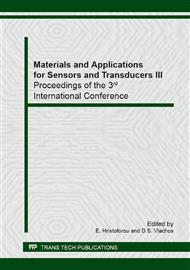p.43
p.47
p.51
p.55
p.59
p.63
p.67
p.71
p.75
The Effect of Frequency on the Flow and Particle Collection Patterns under Electroosmosis
Abstract:
The collection and manipulation of small objects is important in bioassays. One commonly used force to manipulate small objects is electroosmosis which has the advantages of easy fabrication and small power consumption. Many factors affect the electroosmosis like surface charge density, applied voltage and frequency. For ac electroosmosis, frequency affects flow pattern and particle collection. In this study, the role of frequency is investigated by experiments and verified by numerical simulation. The electroosmosis collecting chip is made of two parallel electrodes separated by a spacer. The chip consists of a top ITO electrode and a bottom electrode made by Corning 1737 glass with different patterned sputtered Cr electrode. The spinning photoresist on the bottom electrode is used as dielectric layer and the electrodes are separated by a curing PDMS spacer. The amine-modified polystyrene particles were collected by varying frequency. To further investigate the mechanism, numerical simulations were carried out using commercial software Comsol with multi-physics setting. The results show the particle flow and collection pattern is sensitive to frequency. For low frequency 100 Hz, the maximum flow velocity occurred in the peripheral boundary of the bottom electrode and the particles are depleted in the central and accumulated in the peripheral area. For high frequency 1000 Hz, the particles are accumulated in the center region of the bottom electrode where the maximum velocity occurs. From simulation, the maximum flow velocity occurs from the boundary towards the center as frequency increases. Meanwhile, the magnitude of the maximum flow velocity is also proportional to the applied frequency. For particles collected by electroosmosis, varying frequency will result in different flow and collection pattern.
Info:
Periodical:
Pages:
59-62
Citation:
Online since:
April 2014
Authors:
Keywords:
Price:
Сopyright:
© 2014 Trans Tech Publications Ltd. All Rights Reserved
Share:
Citation:


